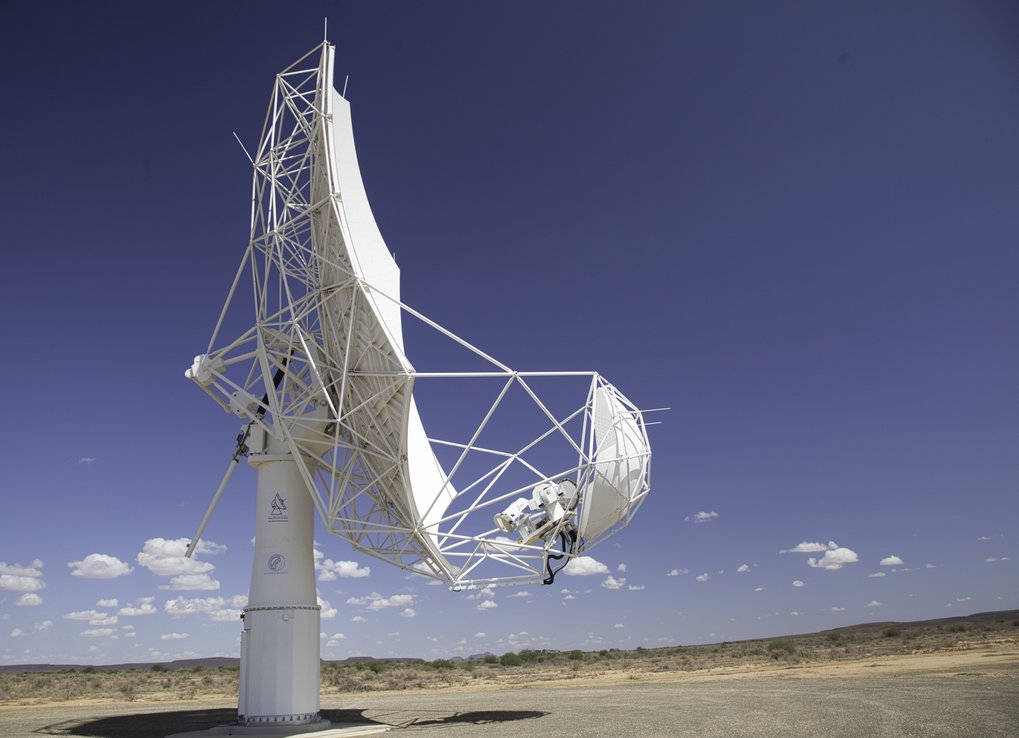The Max-Planck-Gesellschaft contributes € 20 million to the extension of the MeerKAT radio telescope in the Karoo semi-desert region
The telescope currently consists of 64 individual antennas electronically interconnected to form a virtual radio telescope with a diameter of eight kilometres. Within the scope of this project, 20 additional antennas will be added to increase their total number to 84. In addition, the virtual diameter of the network will be extended to cover 17 kilometres. This will greatly increase sensitivity, angular resolution, and image quality. The extension is jointly funded by the South African Radio Astronomy Observatory (SARAO) and the Max-Planck-Gesellschaft in Germany.

The scientific goal includes extensive mapping of the southern sky in observation frequencies that will help drive forward future investigations. Among other things, pulsars, fast radio outbursts, large-scale structures in the universe, extragalactic objects, and sources in our Milky Way will be investigated.
The MeerKAT radio telescope is a precursor of the "Square Kilometre Array" (SKA), the project to build a radio telescope with global participation and telescope sites in southern Africa and Australia. The extended MeerKAT telescope will be integrated into the part of the SKA project located in southern Africa and will form part of the SKA telescope comprising 197 antennas.

These radio telescopes will enable significantly improved investigations in various fields of radio astronomy. The measurement of extremely accurate pulsar clocks will make it possible to detect distortions in space-time and thus detect extremely long-wave gravitational waves. The exploration of young galaxies at large redshifts could help reveal the nature of the mysterious Dark Energy. Maps of the three-dimensional distribution of cosmic magnetic fields can help elucidate their effects on objects in the universe. A look back into what is referred to as the "Dark Age" (before the universe shone in the light of stars and galaxies) would help scientists understand how black holes and stars were formed. The study of complex molecules could also help improve our understanding of the origin of life in the universe.
The South African partners are responsible for setting up the local infrastructure, some of the receiver systems including the cooling thereof, and the equipment for data analysis. The German partners will provide the new telescopic antennas in the form of parabolic mirrors for the "Square Kilometre Array" as well as the receivers and systems for data acquisition and processing. Both partner countries will be contributing € 20 million (or 400 million South African rand) each to the project.
Molapo Qhobela, the Chief Executive Officer of the National Research Foundation in South Africa, expects that the MeerKAT extension will provide a much more powerful telescope for studying the formation and evolution of galaxies. "The extension of MeerKAT will increase the sensitivity of the receiving systems by about 50 percent, thus enabling a much faster mapping of the sky and the detection of extremely faint astronomical sources".

"I am impressed by what has been achieved so far with the MeerKAT telescope. We are proud to cooperate with our South African partners in the extension of the telescope", says Martin Stratmann, President of the Max-Planck-Gesellschaft, who visited the MeerKAT site in South Africa in January 2020. "This really must be experienced up close - it is quite an impressive sight!"
The MK+ project was launched in 2019 following thorough scientific evaluation and technical planning. The first activities for on-site construction are planned for mid-2021. The further steps up to completion and scientific commissioning should be completed by 2023.






